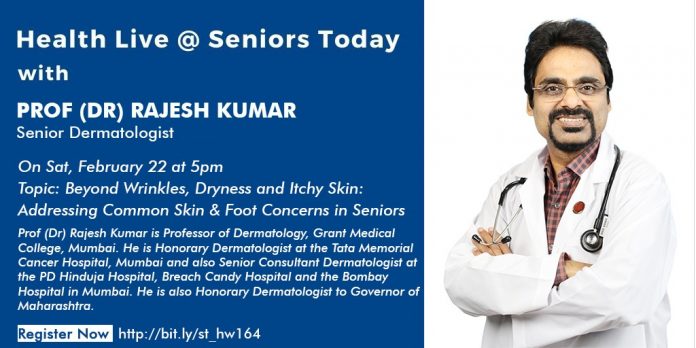Prof (Dr) Rajesh Kumar is Professor of Dermatology, Grant Medical College, Mumbai. He is Honorary Dermatologist at the Tata Memorial Cancer Hospital, Mumbai and also Senior Consultant Dermatologist at the PD Hinduja Hospital, Breach Candy Hospital and the Bombay Hospital in Mumbai
Changes in skin in old age include:
- The skin in old age becomes thin.
- The outer layer of the skin becomes thin making the skin appear more pale and transparent
- Loss of elasticity
- Dryness
- Appearance of fine and coarse wrinkles
- Age spots- these are flat, brown spots (hyper pigmented macules) that appear on the skin exposed to sun. Some of them can also be elevated. These are also called seborrheic keratosis
- Easy bruising- the blood vessels of the skin become more fragile making the skin easier to bruise
- Increased risk of skin cancers
The skin appears shrivelled and thinned out. The epidermis, dermis and subcutaneous tissue becomes thinner with age. It appears cigarette paper thin.
How to prevent early ageing of skin:
- Apply sunscreen and protective clothing
- Eat a balanced diet
- Drink adequate amounts of water
- Keep your skin moisturised
- Use retinol creams. But you should look for an adequate percentage of retinol, such that it does not irritate your skin. It should only be applied to your face or an area that is cosmically important to you
- There are a lot of over the counter anti-aging skin care products available which you can try
- Age spots are hyper pigmented macules which are, in medical terms called, seborrheic keratosis. These are also called wisdom spots. These are non cancerous skin grows. If these are cosmetically displeasing to you, you can also have them removed.
- You can prevent these by:
- Applying a broad spectrum sunscreen. For the Indian skin SPF 50 or higher is recommended.
- Wear protective clothing such as long sleeved clothes such as shirts and pants and long brimmed hats.
- Avoid excessive sun exposure
-
- Treatment options include:
-
-
- Retinol
- Laser therapy
- Chemical peels
- Cryotherapy
-
When to seek medical advise:
- When you see any new or unusual spots
- If you see spots or sores which are small, shiny or waxy, scaly and rough, or if you see any crusting or bleeding
- Bruising is also another common occurrence in old age because of thinning of blood vessels which rupture easily. Even a trivial trauma such as rubbing your skin can cause rupture of the superficial vessels. The blood then comes out, and accumulates under the superficial skin, which is why it looks scary but harmless.
- This is called senile purpura.
- No treatment is required. These are more common when the patient is on blood thinners.
- In the Indian population and skin, we usually get non melanoma skin cancers such as Basal Cell Carcinoma and Squamous Cell Carcinoma.
- If you see any growth on your skin, consult your dermatologist.
- Sometimes these lesions can turn out to be superficial basal cell carcinoma. Basal cell carcinomas are non aggressive tumours which are locally invasive, ie, they do not affect any other part of the body or invade any other organs.
- When a growth looks like a cauliflower, it can have a Squamous Cell Carcinoma which is a malignant carcinoma. It is very rare. The treatment includes excision of the tumour growth with a margin. The spread of the disease can be looked for with a PET Scan.
- Skin infections are very common these days, widespread fungal infections.
- These usually present as small nodules in a ring lesion.
- Topical steroid application should be avoided. Apply only anti- fungal agents, otherwise the lesion is going to stay for a longer duration of time.
- Many times, in diabetic patients such infections are more common.
- The common sites for infection include the inter web space between your toes, groin region, infra- mammary region.
- You should consult your physician before applying any topical agent. This is because if you do not apply the adequate and appropriate amount of topical agent, your body may become resistant to the anti fungal agent and that can become a lot more difficult to treat.
- Occasionally, if the infection covers more than 20% of the body surface area, you may also be prescribed oral anti fungal agents such as Itraconazole, Terbinafine, additionally.
- You should take the following precaution/ measures if you have a fungal infection:
-
- Wash the affected area daily and dry it thoroughly
- Change your underwear/ socks daily, especially if they become damp/ soiled
- Wear loose fitting clothing, preferably made of cotton
- Avoid sharing towel, bed sheets, combs, and other personal hygiene items
Calluses are another problem that are seen in the elderly, this is because of wearing ill fitted shoes and footwear due to repeated friction.
The treatment includes wearing correct sized shoes and appropriate footwear. These shoes should be advised by a podiatrist or a dermatologist.








